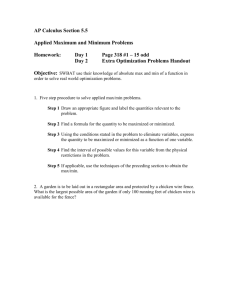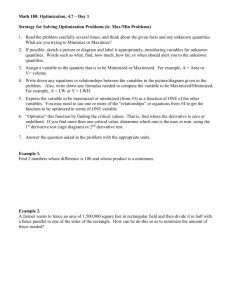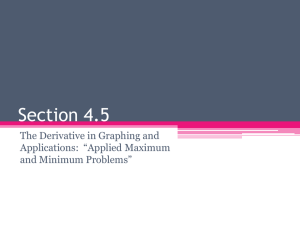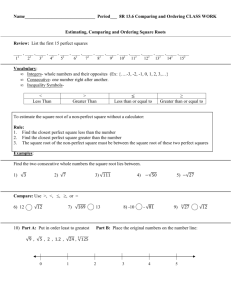2.13 Notes Optimization Problems
advertisement
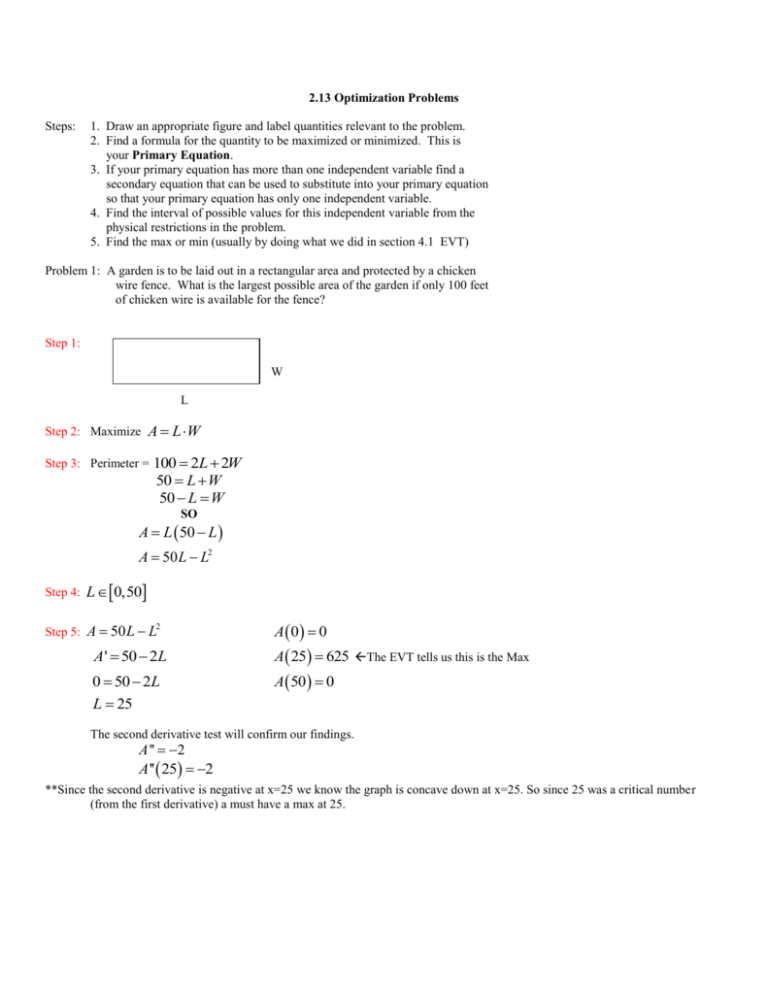
2.13 Optimization Problems Steps: 1. Draw an appropriate figure and label quantities relevant to the problem. 2. Find a formula for the quantity to be maximized or minimized. This is your Primary Equation. 3. If your primary equation has more than one independent variable find a secondary equation that can be used to substitute into your primary equation so that your primary equation has only one independent variable. 4. Find the interval of possible values for this independent variable from the physical restrictions in the problem. 5. Find the max or min (usually by doing what we did in section 4.1 EVT) Problem 1: A garden is to be laid out in a rectangular area and protected by a chicken wire fence. What is the largest possible area of the garden if only 100 feet of chicken wire is available for the fence? Step 1: W L Step 2: Maximize A L W Step 3: Perimeter = 100 2L 2W 50 L W 50 L W SO A L 50 L A 50 L L2 Step 4: L0,50 Step 5: A 50 L L 2 A 0 0 A ' 50 2L A 25 625 The EVT tells us this is the Max 0 50 2L L 25 A 50 0 The second derivative test will confirm our findings. A '' 2 A '' 25 2 **Since the second derivative is negative at x=25 we know the graph is concave down at x=25. So since 25 was a critical number (from the first derivative) a must have a max at 25. Problem 2: An open box is to be made from a 16” x 30” piece of cardboard by cutting out squares of equal size from the four corners and bending up the sides. What size should the squares be to obtain a box with largest volume? 30 Step 1: X 16 X 16-2x X X 30-2x Step 2: Primary Equation V x 16 2 x 30 2 x Step 3: We do not have a step 3 for this problem because our primary equation only has one variable to solve for. V x 480 32 x 60 x 4 x 2 V 4 x3 92 x 2 480 x V ' 12 x 2 184 x 480 0 4 3 x 2 46 x 120 4 3x 10 x 12 x Step 4: Step 5: 10 3 " (Cut out squares " 10 10 x ) x 12 Doesn’t fit in our interval so we will throw out this answer. 3 3 x 0,8 V 0 0 3 2 10 10 10 10 V 4 92 480 3 3 3 3 4000 9200 4800 27 9 3 4000 27600 43200 19600 27 27 27 27 3 10 19600in 3 (Max) 725.93in V 3 27 V 8 0 Problem 3: See Diagram. An offshore oil well is located at a point W that is 5 km from the closest point A on a straight shoreline. Oil is to be pumped from W to a shore point B that is 8 km from A by piping it on a straight line under water from W to some point P between A and B and then on to B via pipe along the shoreline. If the cost of laying pipe is $1,000,000 / km underwater and $500,000/ km over land, where should point P be located to minimize the cost of laying pipe? Step 1: W 5 km Y X A (8-x) P 8 km Step 2: Primary equation C 1y .5 8 x B Cost in millions. Goal is to minimize cost. Step 3: Secondary equation x 2 52 y 2 x 2 25 y Thus: C 1 x 2 25 .5 8 x C x 2 25 4 .5 x Step 4: Range x 0,8 Step 5: 1 1 2 x 25 2 2 x 0 .5 2 x 1 2 x 25 2 C' C' 2 x x 2 25 2 x 2 25 *We only care when the numerator is zero, because the denominator is always positive on [0,8]. 2 x x2 25 0 2 x x2 25 2x 2 x 2 25 2 4 x 2 x 2 25 3 x 2 25 25 x2 3 5 5 x 3 3 (the negative result does not make sense in this problem, so we throw out that answer; also- C 0 9 5 is not in [0,8].) 3 $9million 5 C 8.330127 $8,330,127 3 C 8 89 9.43381 $9, 433,981 Answer: P should be located 5 km right of A. 3 2 Problem 4: Find a point on the curve y x that is closest to the point ( 18, 0 ). Step 1: (x,y) d (18,0) Step 2: primary equation d x 18 y 0 d x 18 2 d x 18 2 2 2 y2 Step 3: x2 2 d x 18 2 x4 2 * d will be minimized at the same x as d will be minimized. d 2 x 18 x 4 2 Step 4: x 0,3.2001085 x 18 x4 2 182 x 18 x 4 18 2 182 x 2 36 x 182 x 4 0 x 4 x 2 36 x 0 x x3 x 36 x0 Step 5: x 3.201085 (obtained using technology) d ' 2 x 18 1 4x 2 1 3 0 2 x 36 4 x3 0 4 x3 2 x 36 2 0 2 x3 x 18 0 x 2 2 x2 4 x 9 x2 d 2 0 182 324 d 2 2 162 16 272 d 272 16.492422 d 2 3.2001085 182 324 Answer: (2,4) is the closest point on the function y=x2 to (0,18).
